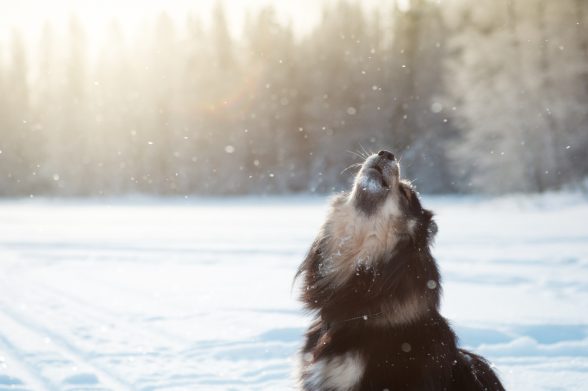
A herding dog’s style of working is enormously influenced by the animal it is tasked to move, as well as the environment in which it works. Perhaps no breed better exhibits the point than the Finnish Lapphund.
Finnish Lapphunds were developed to herd reindeer in a huge geographical area that covered Lapland, northern Sweden, Norway and Finland. Lapps describe the breed as a galloping dog, and while a Lapphund can easily transition from a trot to a gallop, the latter is its most natural style of movement. Galloping doesn’t offer much endurance, but it is fast, and it allows the dog to catch up to a longer legged animal.
In addition to longer legs, reindeer have large, broad, and hairy hooves that allow the animal to move quickly over snow without sinking in (think snowshoe), but a reindeer is also apt to turn quickly and trample an inattentive Lapphund. For that reason, the breed has developed a strong “startle reflex,” a survival mechanism that keeps a dog from being squashed by a beast that can weigh hundreds of pounds. This reflex, in fact, is written into the breed standard. Lapphunds, however, recover quickly and return to their job as brave, active and noisy herding dogs that think!
Reindeer herds aren’t driven the way sheep or cattle are, and thus, Lapphunds work to keep a herd together, not direct it. They have a strong instinct to “gather,” but not necessarily to move the livestock from point A to point B. Neither do Lapphunds use “eye” or work low (crouch) to work because reindeer aren’t easily intimidated by a dog. Bouncing and barking, however, seems to work on these members of the deer family, and it has for centuries. Some dogs are more vociferous than others, but in their natural working environment, Lapphunds use their voices to herd reindeer. It’s a critical part of their working style, and Lapphunds have a natural inclination to bark.
Herding reindeer takes a whole different skill set, and it’s a somewhat contradictory job because a dog must have a basic need to control the animal, but also to get away from it in a heartbeat. The Lapphund does both.
We leave you with a few interesting factoids about reindeer.
They are the same animal as caribou, and while they are called reindeer in Europe, they are called caribou in North America if they are wild, but reindeer if they are domesticated;
Compared to their body size, reindeer have the largest and heaviest antlers of all living deer species, and both male and female reindeer grow them (in most other deer species, only males have antlers);
You may have noticed further about that we described reindeer hooves as hairy. Reindeer, in fact, are covered in hair from their nose to the bottom of their hooves, and yes, hairy hooves look odd, but they give a reindeer a good grip when walking on frozen ground, ice, mud, and snow. They are also the only deer species to have hair completely covering their nose. It helps to warm incoming cold air before entering the lungs, and helps the reindeer find food hidden under snow.
